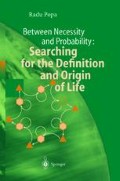Abstract
So far no theory, no approach, no set of formulas, and no blackboard scheme have been found satisfactory in explaining the origin of life. The absence of solid experimental evidence is the largest drawback in the theoretical models of early life. Therefore, no one may claim the  ultimate model’. At the current level of knowledge, this remains impossible. The theory presented here gathers what I consider the most compelling data into a model based on the principles of hierarchical accretion. The challenge to any hierarchical theory about the origin of life is to organize the early achievements of life in a sequence that is thermodynamically meaningful and provides temporal direction (overall increase in stability and efficiency). Some of the major assumptions of this model are as follows:
ultimate model’. At the current level of knowledge, this remains impossible. The theory presented here gathers what I consider the most compelling data into a model based on the principles of hierarchical accretion. The challenge to any hierarchical theory about the origin of life is to organize the early achievements of life in a sequence that is thermodynamically meaningful and provides temporal direction (overall increase in stability and efficiency). Some of the major assumptions of this model are as follows:
Preview
Unable to display preview. Download preview PDF.
Author information
Authors and Affiliations
Rights and permissions
About this chapter
Cite this chapter
Radu, P. Assembling the Early Puzzle of Life. In: Between Necessity and Probability: Searching for the Definition and Origin of Life. Advances in Astrobiology and Biogeophysics, vol 2. Springer, Berlin, Heidelberg. https://doi.org/10.1007/978-3-540-39955-1_8
Download citation
DOI: https://doi.org/10.1007/978-3-540-39955-1_8
Published:
Publisher Name: Springer, Berlin, Heidelberg
Print ISBN: 978-3-540-20490-9
Online ISBN: 978-3-540-39955-1
eBook Packages: Springer Book Archive

